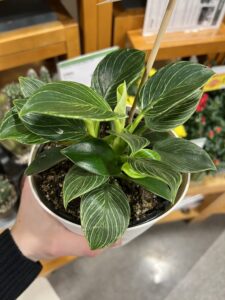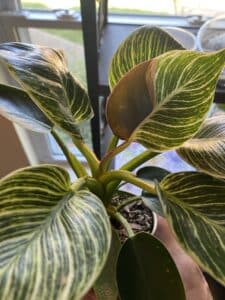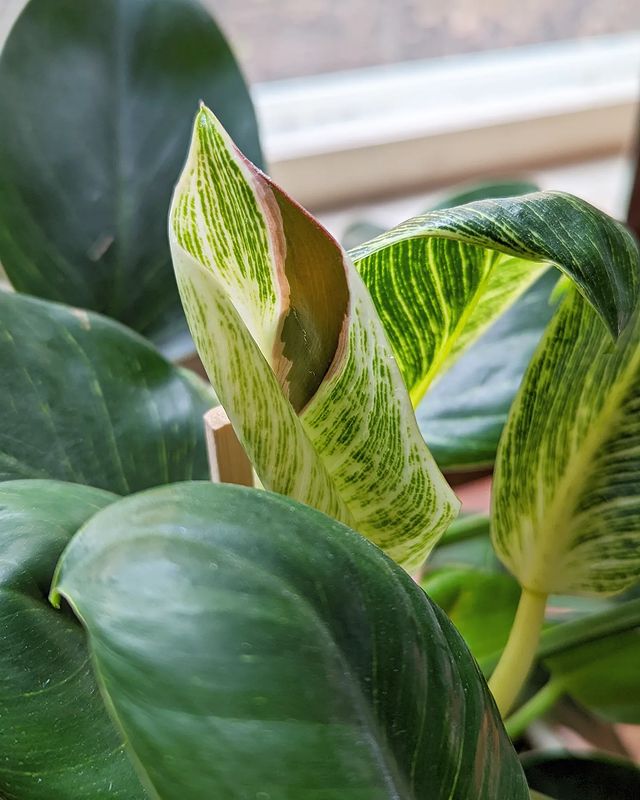Last summer, I bought Philodendron birkin for my girlfriend, but she had already flown to New York. Thus, I had to own it and grow it with good care, and the plant grew beautifully.
After a few weeks after I uploaded the picture with the Philodendron birkin hashtag, I saw other plants had variegation while mine did not.
There, I found users with a “reverting problem” commented on other posts after some additional research.
Generally, Philodendron birkin reverting is a process of plants losing their variegation due to various contributing factors. Low sunlight, improper watering habits, and nutrient deficiency usually trigger reverting symptoms.

It was baffling as I was missing out on variegation regardless of my best efforts to give my Philodendron an ideal home.
Later, I realized Philodendron birkin reverting can be prevented before reverting begins.
Therefore, to stay on the safe side with the beautiful Philodendron birkin variegation, continue reading till the end.
Table of Contents Show
Do Philodendron Birkin Revert?
Philodendron birkin is an unstable rare breed or mutation of Philodendron Rojo Congo and Green-Leaf Philodendron.
This exotic tropical beauty generally has whitish or creamy stripes over the greenish leaf surface.
But the alluring look of Philodendron birkin might not be permanent due to the unstable heredity of the plant.
Philodendron birkin is not completely stable in appearance, so it is reasonable for the plant to follow its old ancestors’ looks.
The creamy white or yellowish stripes on the Philodendron birkin leaf are the variegation caused by cellular mutation.
Under various circumstances, the variegated plant tends to lose variegation and become a normal green leaf.
The process of the Philodendron birkin leaf losing its beautiful variegation is commonly known as reverting.

Generally, reverting causes the Philodendrons to go back completely green, losing all of their magnetic stripes on glossy foliage.
Philodendron birkin undergoes a unique form of variegation known as chimeric, imposing the plant with veiny-like streaks along its body and edge.
Even though reverting is a harmless process, it could be disappointing to witness losing those gorgeous stripes.
Meanwhile, reverting is not an overnight phenomenon and is not mandatory for all Philodendron birkin plants.
Therefore, if you are giving an ideal home to your Philodendron, you may not even need to worry about losing variegation.
Why Do Philodendron Birkin Revert?
Losing the key attractive feature of Philodendron birkin could take a toll on you.
When Philodendron birkin leaves age, they undergo losing their variegated form. These leaves start to darken, and the little markings on the surface begin to fade. This is a normal and natural process.
But remember, it could also be because of your incompetence.
Birkin often seemingly loses its stripes and mimics old parents’ looks if not treated with proper care and attention.
In contrast, Philodendron birkin living in a dream home is unlikely to go down the reverting path.
Therefore, the best way to prevent Philodendron birkin from reverting is via optimal care and affection.

Meanwhile, you may wonder what kind of mishaps in the care routine induces this unpleasant reverting process.
Plants can experience multiple variegation types such as blister or reflective, chimeral, pattern gene, viral variegation, and transposon.
Let us start with the factors responsible for reverting Philodendron birkins, shall we?
1. Insufficient Sunlight
Amongst the many gardeners’ experiences, insufficient sunlight is the major reason for Philodendron birkin reverting.
Generally, Philodendron birkin tends to stay delighted in bright, indirect sunlit places for at least 12 hours a day.
If your Philodendron shows up early signs of reverting, you might need to reconsider lighting for the plant.
That said, you shall avoid placing your Philodendron birkin on direct sun exposure as leaves easily get sunburned.
Immediate Actions to Take
- Try placing your plant in a bright place, such as an east or south-facing window with a sheer curtain.
- Morning sunlight can do wonders, so ensure your plant receives a few hours of early morning sunshine.
- Ensure no dark shade is falling on the plant or object obstructing light to the plant.
- Keep the plant at least 3 to 5 feet away from the window to avoid sunburn.
- In the absence of sunlight, use 200W artificial grow lights for almost at least 8 hours.
If you do not want your Philodendron reverting, learn about Philodendron light requirements.
2. Improper Watering
Improper watering is another care factor responsible for Philodendron birkin reverting.
Philodendron birkin is a moderately thirsty plant that prefers to have its soil moist most of the time.
Generally, fetching Philodendron birkin water on a weekly routine will be enough to sustain its tropical beauty.
Meanwhile, this Philodendron slightly tolerates underwatering conditions better than excess water. But do not push the plant over the edge with minimal watering.

Both issues cause Philodendron birkin to revert to Rojo Congo or Green-Leaf Philodendron.
Immediate Actions to Take
- Poke chopsticks into the soil and check the moisture on the chopstick. If the chopstick is moist, wait for a day to water.
- Similarly, you shall opt for the bottom-watering approach as it promotes better root growth.
- Furthermore, you can invest in a moisture meter to inform yourself about water needs.
- Water your plant enough until the pot drains out from below if the plant has undergone the underwatering.
- If the Philodendron has not finished socking the moisture, place the plant in a brighter space. Avoid watering for a couple of days until the soil dries completely.
3. Temperature Stress and Improper Humidity
Like any other Philodendron plant, Philodendron birkin also suffers greatly from temperature fluctuation.
The grave consequence of temperature stress is that Philodendron birkin tends to lose its wonderful white stripes.
Generally, the ideal growing condition for Philodendron birkin is between 55°F to 86°F temperature with 40-70% humidity.
Therefore, a temperature that is too low or above the recommended range can induce reverting and degradation of plant health.
Meanwhile, to keep your Birkin happy and healthy with variegation intact, you must ensure moderate humidity.
Immediate Actions to Take
- Place the plant pot over the heating pads to keep it warm during winter.
- Avoid keeping the plant near heat appliances like heaters, air conditioners, vents, etc.
- Cover the plant with frost blankets to protect them from cold frosts.
- Add straws or mulches on top of the soil to trap the heat and keep plants warm.
- Mist your plant in an alternating day fashion during morning hours.
- Try placing the plant in a well-lit kitchen or bathroom where humidity is around 60%.
- Place the plant pot over the pebble tray partially filled with water to keep humidity in check.
4. Fertilization Problem
Nutrient deficiency is a condition of victuals in the soil responsible for maintaining the plant’s stature.
Generally, a lack of nutrients like nitrogen or phosphorus in the soil is most likely to cause reverting.
Nutrient deficiency could be a result of under-fertilization or improper choice of fertilizer.
Meanwhile, excessive use of fertilizer can cause stacking of nutrients, making the soil toxic for plants.

Therefore, you must be aware of the proportion of nutrients in the fertilizer before its application.
Immediate Actions to Take
- Collect the balanced fertilizer and dilute fertilizers to their half strength. If not, slow-releasing fertilizers can be the best to apply.
- Check the moisture of the soil and water the plant, and let it rest overnight.
- Apply the fertilizer without contacting the leaf and stems of the plant.
Avoid high nitrogen fertilizers that will stimulate chlorophyll production, “greening” Philodendron birkin, thus reducing variegation.
How to Prevent Philodendron Birkin from Reverting?
If your Philodendron birkin is already on the way to reverting, there is almost nothing you can do except keep providing them with optimal care.
However, you can prevent loss of variegation by giving them excellent care before reverting.
Therefore, let us start with the ideal care requirements of Philodendron to prevent it from reverting.
- Ensure your Philodendron birkin receives indirect bright sunlight for at least 12 hours daily. Also, rotate the plant once in a while to promote uniform growth.
- Water once a week during the active growing season or when the top 2” of soil is dry.
- Ensure to use well-draining soil with optimal aeration and a slightly acidic pH of 6 to 7.
- Maintain moderately humid conditions with sufficient warmth.
- Provide monthly fertilization during the active growing seasons, i.e., spring and summer, every month.
- Repot the plant after it begins to outgrow the current pot with roots shooting out from the drain hole.
- Occasionally prune off damaged or decaying leaves to redirect energy for newer foliage.
Conclusion
Although the reverted Philodendron birkin does not have disappointing looks, variegated leaves are always preferred for their distinct looks.
Therefore, to protect your Philodendron birkin from reverting, you must provide them with optimal care and affection.
All The Best!!!
Do you know Albino Monstera is indeed real? Get the answer here!


